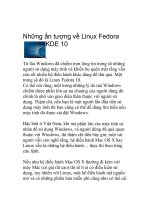Starting with Fedora Linux
Bạn đang xem bản rút gọn của tài liệu. Xem và tải ngay bản đầy đủ của tài liệu tại đây (189.43 KB, 12 trang )
Starting with
Fedora Linux
Whether you use Fedora Linux every day or just
tweak it once in a while, a book that presents effi-
cient ways to use, check, fix, secure, and enhance
your system can be an invaluable resource.
Fedora Linux Toolbox is that resource.
Fedora Linux Toolbox is aimed primarily at Fedora
and Red Hat Enterprise Linux power users and
systems administrators. To give you what you
need, we tell you how to quickly locate and get
software, monitor the health and security of your
systems, and access network resources. In short,
we cut to the most efficient ways of using Fedora.
Our goal with Fedora Linux Toolbox is to pack a lot of useful information
for using Fedora Linux into a small package that you can carry around
with you. To that end, we describe:
❑ Commands — Tons of command line examples to use Fedora in
helpful and clever ways.
❑ GUI tools — Quick pointers to graphical administration tools to
configure your system.
❑ Software repositories — Short procedures to find and download
thousands of applications.
❑ Online resources — Listings of the best locations to find Fedora
forums, mailing lists, IRC channels, and other online resources.
❑ Local documentation — Tools for gathering more information from
man pages, doc directories, help commands, and other resources on
your Fedora system.
Because you’re not a beginner with Linux, you won’t see a lot of screen-
shots of windows, icons, and menus. What you will see, however, is the
IN THIS CHAPTER
Find Fedora resources
Learn quick and
powerful commands
Have a handy refer-
ence to many useful
utilities
Work as Linux gurus do
82911c01.qxd:LinuxToolbox 10/18/07 3:52 PM Page 1
quickest path to getting the information you need to use your Fedora Linux system to
its fullest extent.
If this sounds useful to you, please read on.
About Fedora, Red Hat, and Linux
Fedora is a Linux operating system that is sponsored by Red Hat, Inc. Its roots come
from Red Hat Linux, which ended its development life under that name in 2003. At
that time, Red Hat transitioned its single Red Hat Linux distribution into Fedora Core
(now called simply Fedora) and Red Hat Enterprise Linux.
❑ Fedora (
) became the community-driven, rapid-
development operating system that was distributed for free (as is) every six to
nine months. The goal was to stay on the cutting edge of open source technology,
while also providing a development platform for enterprise-quality software that
could become part of Red Hat Enterprise Linux.
❑ Red Hat Enterprise Linux (RHEL) became the commercial, subscription-based
Linux operating system produced by Red Hat, Inc. (
www.redhat.com
). The goal
was to release RHEL on about an 18-month schedule. Red Hat has since built its
product line around RHEL, offering support, training, documentation, hardware
certification, and other products to support RHEL customers. In 2006, Red Hat
purchased the open source Java development vendor JBoss, so Red Hat can now
offer a complete application stack composed of middleware running on top of its
RHEL product line.
Because Fedora and RHEL are open source operating systems, built on the GNU pub-
lic license, people can take the source code from those Linux systems and create their
own Linux distributions. And that’s just what they have done. For that reason, the
skills you learn here with Fedora could also help you if you use any of the following
operating systems:
❑ CentOS (
www.centos.org
) — Many Linux consultants who don’t need Red Hat’s
commercial support and don’t want to pay Red Hat subscription fees have migrated
to CentOS. CentOS is a rebuild of RHEL source code, with a goal of 100-percent
binary compatibility with RHEL.
Aside from logos and other Red Hat branding information (which CentOS
removed), applications and interfaces should be exactly the same for CentOS and
RHEL. Of all the RHEL rebuilds, CentOS is the one most widely adopted and the
one we recommend.
❑ Yellow Dog Linux (
www.yellowdoglinux.com
) — Based originally on Red Hat
Linux, Yellow Dog Linux runs on a variety of Apple hardware (PowerBook, iBook,
iMac, G3, G4, G5, and so on) as well as on PlayStation 3.
2
Chapter 1: Starting with Fedora Linux
82911c01.qxd:LinuxToolbox 10/18/07 3:52 PM Page 2
❑ Other RHEL and Fedora rebuilds — Other rebuilds of RHEL include Lineox
(
www.lineox.net
) from Finland and Scientific Linux (
www.scientificlinux
.org
), which was created by Fermilab of the U.S. Department of Energy. Linux
distributions such as those just mentioned were created primarily to allow an
organization that once relied on Red Hat Linux to roll their own enterprise-
quality distribution for their organization’s needs.
There is a larger list of Linux distributions built on Fedora and RHEL at DistroWatch
(
/>). Other Linux
systems also have drawn heavily from technology developed at least in part by Red
Hat. For example, distributions such as Mandriva, PCLinuxOS, and Linspire use the
RPM package management system described in this book for managing software pack-
ages, so descriptions of rpm in Chapter 2 will help you with Mandriva, PCLinuxOS,
and Linspire as well.
Comparing Fedora to Other Linuxes
Fedora is the rapid-development, cutting edge Linux system, as compared with the
more stable, less-often-updated Red Hat Enterprise Linux. The speed at which Fedora
is developed (with a new release about every six months) makes it perfect for the Linux
enthusiast who wants the latest releases of software and can deal with some level of
instability.
Using Fedora Linux might be the best way to learn Linux if you have an eye toward
becoming a Linux professional. With its short development cycle, you can be assured
that you have the newest cool features to use. Because Red Hat uses Fedora as a plat-
form for testing its commercial software, the skills you learn will scale up nicely to
the largest enterprise computing environments.
Besides Red Hat, Novell is the other major corporation that is marketing Linux in the
enterprise market. Novell’s operating systems follow the same basic dual-distribution
model, with SUSE Linux Enterprise as the basis of its commercial products and
OpenSUSE as its free, community-driven Linux system. Some open source enthusi-
asts, however, question Novell’s long-term commitment to open source because of
its 2006 “covenant not to sue” with Microsoft (see
www.novell.com/linux/
microsoft/covenant.html
).
Debian is considered to be a high-quality Linux distribution with a strong commit-
ment to the ideals of open source software. Many derivative Linux distributions,
such as the popular Ubuntu Linux and the KNOPPIX live CD, are based on Debian.
Although Debian is good for use in small business, the project doesn’t have the same
enterprise infrastructure (training, support, documentation, and so on) that is built
around RHEL. However, Ubuntu has begun offering paid enterprise-level support
contracts (
www.ubuntu.com/support/paid
).
3
Chapter 1: Starting with Fedora Linux
82911c01.qxd:LinuxToolbox 10/18/07 3:52 PM Page 3
Finding Fedora Resources
The center for information about the Fedora project is the FedoraProject.org web site
(
/>). This is the official site for the Fedora project.
Particularly useful pages from this site include the following:
❑
fedoraproject.org/wiki/Communicate
— From the Communicating and
Getting Help page, follow links to documentation, FAQs, bug reporting, mailing
lists, IRC chats, forums, and community web sites.
❑
fedoraproject.org/wiki/Distribution
— Links to information for down-
loading or purchasing Fedora installation CDs or DVDs are listed on this site.
Some links also take you to details on upgrading and life cycles of each Fedora
release.
❑
fedoraproject.org/wiki/FAQ
— This FAQ contains excellent information on
how to start with Fedora, use it, get help and support, and understand the parts
that make up the Fedora project. This is also the first place to go for questions on
hardware compatibility and on what software is and isn’t included in Fedora.
❑
fedoraproject.org/wiki/ForbiddenItems
— Software that is available for
Linux, but not included in Fedora because it does not meet Fedora’s requirements
relating to legal restrictions or source code availability, is listed on this page. We
indicate how you can legally get some of these items in appropriate sections of
this book.
❑
fedoraproject.org/wiki/Bugs/FC6Common
— Problems you may encounter
that have not yet been fixed are described on this page. There is also information
on getting update disks that include software fixes.
Fedora Community Connections
If you want to communicate with the Fedora community, Table 1-1 shows a quick list
of links to the most useful Fedora and RHEL communications venues.
Table 1-1: Online Resources to Connect to the Fedora Community
Fedora Activities Internet Sites
Mailing lists
www.redhat.com/mailman/listinfo
IRC chats
fedoraproject.org/wiki/Communicate#IRC
Forums
FedoraForum.org
LinuxForums.org
Communities
FedoraFaq.org
fcp.surfsite.org
FedoraUnity.org
FedoraSolved.org
4
Chapter 1: Starting with Fedora Linux
82911c01.qxd:LinuxToolbox 10/18/07 3:52 PM Page 4
Table 1-1: Online Resources to Connect to the Fedora Community
(continued)
Fedora Software
Before Fedora 7, development of Fedora software consisted of the basic operating
system (Fedora Core) and contributed outside packages (Fedora Extras). With the
merge of Fedora Core and Fedora Extras software into one massive repository sim-
ply named Fedora, you can now go to one location to get all the software projects
that have been packaged to run on Fedora Linux (see
http://fedoraproject
.org/get-fedora.html
).
Sites that offer software packages built for Fedora that are outside the Fedora project
jurisdiction include
,
,
http://
freshrpms.net
, and
/>. Information on how to use
these and other Fedora software repositories is contained in Chapter 2.
Focusing on Linux Commands
These days, many important tasks in Linux can be done from both graphical inter-
faces and from commands. However, the command line has always been, and still
remains, the interface of choice for Linux power users.
Graphical user interfaces (GUIs) are meant to be intuitive. With some computer experi-
ence, you can probably figure out, for example, how to add a user, change the time and
date, and configure a sound card from a GUI. For these cases, we’ll mention which
graphical tool you could use for the job. For the following cases, however, you will
probably need to rely on the command line:
❑ Almost any time something goes wrong — Ask a question at an online forum to
solve some Linux problem you are having and the help you get will almost always
come in the form of commands to run. Also, command line tools typically offer
much more feedback if there is a problem configuring a device or accessing files
and directories.
❑ Remote systems administration — If you are administering a remote server, you
may not have graphical tools available. Although remote GUI access (using X appli-
cations or VNC) and web-based administration tools may be available, they usually
run more slowly than what you can do from the command line.
Fedora Activities Internet Sites
News
FedoraNEWS.org
Social Networks
groups.myspace.com/fedoraproject
www.frappr.com/fedora
www.flickr.com/groups/fedora
5
Chapter 1: Starting with Fedora Linux
82911c01.qxd:LinuxToolbox 10/18/07 3:52 PM Page 5









